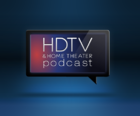 Sep 23
Sep 23 Podcast #497: Optoma HD33 3D 1080p Projector
 Podcast,
Podcast,  Review Tags:
Review Tags:  3D,
3D,  Netflix,
Netflix,  Projectors
Projectors  One complaint we have about 3D is that it needs to be immersive if you are to appreciate the effect. Since most of us can’t afford 100 inch plasmas, a front projector is pretty much the only choice you have for this type of experience, albeit an expensive one. Enter the Optoma HD33 (Buy Now $1500). Its a 1080p DLP projector that supports 3D.
One complaint we have about 3D is that it needs to be immersive if you are to appreciate the effect. Since most of us can’t afford 100 inch plasmas, a front projector is pretty much the only choice you have for this type of experience, albeit an expensive one. Enter the Optoma HD33 (Buy Now $1500). Its a 1080p DLP projector that supports 3D.
Listen to the show
Today's Show:
Blu-ray Reviews:
News:
- Netflix explains everything with an email... Huh? Qwikster?
Other:
Optoma HD33 3D 1080p Projector
One complaint we have about 3D is that it needs to be immersive if you are to appreciate the effect. Since most of us can’t afford 100 inch plasmas, a front projector is pretty much the only choice you have for this type of experience, albeit an expensive one. Enter the Optoma HD33 (Buy Now $1500). Its a 1080p DLP projector that supports 3D.
Features
- Bright at 1800 ANSI lumens and contrast ratio of 4000:1
- 3D-capable for Blu-ray and gaming consoles
- Up to 300" screen size for large group viewing
- Features Texas Instruments 1080p DLP chipset
- PureMotion image processing ensures smooth, judder-free images
The HD33 measures 14.17 x 4.52 x 12.24 inches and weighs 7.7 lbs which makes it easy to mount. It does not have lens shift so where you mount it is important. You’ll want this projector to be as close to head on as you can to avoid any Keystone affect. There are two HDMI v1.4a, VGA-In,Component Video, Composite,Video, Mini-din (IR Emitter), RS-232, and +12V Trigger, VESA 3D Port which means you can pretty much hook up anything to it. For our evaluation we used one of the two HDMI ports.
Although the HD33 says it is 1800 lumens none of the presets produced anywhere near that much brightness when projected on a 100 inch screen from 14 feet away. More than likely the projector’s technical specification is 1800 lumens but its practical application is more like 1200. For our evaluation we opted to use the “Reference” preset to see what kind of results you could get out of the box. BTW, the lamp is rated for 3000 to 4000 hours depending on the brightness setting. Replacement lamps go for around $250.
Performance
As stated earlier we used the “Reference” preset and were quite pleased with what we saw. In a dark room the colors were bright and vivid. Perhaps just a tad too bright. Detail was sharp and shadows were easy to make out. Even though the projector is rated at 1800 lumens we found that the image washed out in a brightened room with the lamp power turned up. Not really anything you can blame on the projector but just a reminder that projection technology needs some sort of light control.
Take the following with a grain of salt, but Ara’s two daughters liked the image that the HD33 produced better than his JVC RS-10. Its probably because the image was more vivid than than the calibrated projector. Black levels were good but not on par with the JVC RS-10 that was being used to A/B against. The JVC produced color that was slightly less vivid and more natural. If this is important to you, we are sure the HD33 will produce similar results, for color, after calibration. Note - unless you like the Soap Opera Effect, turn off PureMotion. It was really meant for sports and live action content. Even then you may still want to leave it off.
On a side note, since this is a DLP you may be concerned about seeing rainbows. Ara could easily see them on his first RPDLP. On his Mitsubishi he could see them on rare occasions. Although we tried to see rainbows on this projector we could not.
The fan noise was almost imperceptible although at times we could hear minor fluctuations depending on what was on screen.
For 3D the HD33 uses an RF solution for synchronizing the glasses. The emitter is small and can be placed were its convenient. The good news is that since you don’t need a line of sight it will be easy to find a place for it. The unit has a separate 3D setting that can be used to tweak the projector for the best 3D picture without affecting the 2D settings. This is a handy feature if you want to brighten the 3D image. Since this was our first native 3D projector we don’t have anything to compare it against, but the image was good. The HD33 will provide an immersive 3D experience.
Conclusion
Overall we were quite impressed with the 2D performance of this projector and found the 3D to be enjoyable to watch. Anyone looking for a 1080p projector whether you like 3D or not should put the Optoma HD33 on their short list. The only real complaints we have about the projector is that there is no lens shift. If you buy this projector be sure to install it as dead on with the screen as possible. Also, it would be nice if Optoma included a pair of 3D glasses in the box. Our evaluation unit came with a pair but the retail version does not. Two pairs of 3D glasses will set you back about $200.


Reader Comments